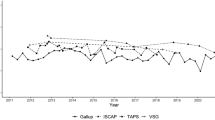Abstract
The defining properties of party identification long established for the United States fail with some frequency to be replicated in electoral systems abroad. A number of plausible suggestions have been made to account for this system-level variability: Most of these have some face merit, but none taken alone is adequate to provide a full cross-system explanation. Variation in party system size or fractionalization has recently been discussed as another source of differential dynamics of party loyalties. Unfortunately, the conventional means of assessing party identification properties are subject to rather severe artifacts, typically ignored, when comparisons are made across systems of very different party size. The conceptual stakes underlying key methods options for such comparisons—most notably, between continuous and discrete statistical tools—are examined. The use of continuous statistics for systems of very multiple parties rests on an assumption that voters do in some degree regard these party systems as imbedded in a continuous space. A simple test for this assumption is mounted in four systems and unsurprisingly it shows very clear support. Analysis of residuals beyond this obvious result add several points of less obvious information about the distribution of party affect in such systems.
Similar content being viewed by others
Author information
Authors and Affiliations
Rights and permissions
About this article
Cite this article
Converse, P.E., Pierce, R. Partisanship and the party system. Polit Behav 14, 239–259 (1992). https://doi.org/10.1007/BF00991980
Issue Date:
DOI: https://doi.org/10.1007/BF00991980




